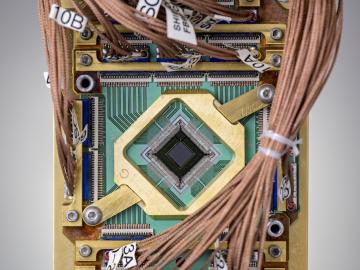
Filter News
Area of Research
- (-) National Security (9)
- (-) Nuclear Science and Technology (10)
- (-) Supercomputing (62)
- Advanced Manufacturing (10)
- Biology and Environment (35)
- Building Technologies (2)
- Computer Science (3)
- Electricity and Smart Grid (1)
- Energy Science (132)
- Energy Sciences (1)
- Functional Materials for Energy (1)
- Fusion and Fission (11)
- Fusion Energy (3)
- Isotope Development and Production (1)
- Isotopes (4)
- Materials (114)
- Materials Characterization (1)
- Materials for Computing (18)
- Materials Under Extremes (1)
- Neutron Science (39)
- Quantum information Science (2)
- Transportation Systems (2)
News Topics
- (-) Frontier (32)
- (-) Materials Science (20)
- (-) Physics (11)
- (-) Space Exploration (8)
- (-) Transportation (8)
- 3-D Printing/Advanced Manufacturing (10)
- Advanced Reactors (13)
- Artificial Intelligence (46)
- Big Data (25)
- Bioenergy (11)
- Biology (14)
- Biomedical (19)
- Biotechnology (3)
- Buildings (4)
- Chemical Sciences (5)
- Computer Science (106)
- Coronavirus (16)
- Critical Materials (3)
- Cybersecurity (23)
- Energy Storage (9)
- Environment (27)
- Exascale Computing (26)
- Fusion (10)
- Grid (11)
- High-Performance Computing (45)
- Isotopes (7)
- Machine Learning (24)
- Materials (16)
- Mathematics (2)
- Microscopy (7)
- Molten Salt (5)
- Nanotechnology (11)
- National Security (36)
- Neutron Science (19)
- Nuclear Energy (42)
- Partnerships (5)
- Polymers (2)
- Quantum Computing (20)
- Quantum Science (26)
- Security (15)
- Simulation (16)
- Software (1)
- Summit (43)
Media Contacts

Twenty-seven ORNL researchers Zoomed into 11 middle schools across Tennessee during the annual Engineers Week in February. East Tennessee schools throughout Oak Ridge and Roane, Sevier, Blount and Loudon counties participated, with three West Tennessee schools joining in.

A multi-institutional team became the first to generate accurate results from materials science simulations on a quantum computer that can be verified with neutron scattering experiments and other practical techniques.

Since the 1930s, scientists have been using particle accelerators to gain insights into the structure of matter and the laws of physics that govern our world.

In the quest for advanced vehicles with higher energy efficiency and ultra-low emissions, ORNL researchers are accelerating a research engine that gives scientists and engineers an unprecedented view inside the atomic-level workings of combustion engines in real time.

Six scientists at the Department of Energy’s Oak Ridge National Laboratory were named Battelle Distinguished Inventors, in recognition of obtaining 14 or more patents during their careers at the lab.

Six ORNL scientists have been elected as fellows to the American Association for the Advancement of Science, or AAAS.

The combination of bioenergy with carbon capture and storage could cost-effectively sequester hundreds of millions of metric tons per year of carbon dioxide in the United States, making it a competitive solution for carbon management, according to a new analysis by ORNL scientists.

Radioactive isotopes power some of NASA’s best-known spacecraft. But predicting how radiation emitted from these isotopes might affect nearby materials is tricky

Oak Ridge National Laboratory scientists have discovered a cost-effective way to significantly improve the mechanical performance of common polymer nanocomposite materials.

After its long journey to Mars beginning this summer, NASA’s Perseverance rover will be powered across the planet’s surface in part by plutonium produced at the Department of Energy’s Oak Ridge National Laboratory.


